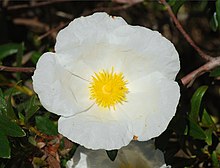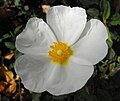Cistus: Difference between revisions
added gum cistus as a common name |
Paul venter (talk | contribs) |
||
| Line 63: | Line 63: | ||
''Cistus'' species are used as food plants by the [[larva]]e of some [[Lepidoptera]] species including ''[[Coleophora|Coleophora confluella]]'' and ''[[Coleophora|Coleophora helianthemella]]'', the latter recorded on ''Cistus monspeliensis''. |
''Cistus'' species are used as food plants by the [[larva]]e of some [[Lepidoptera]] species including ''[[Coleophora|Coleophora confluella]]'' and ''[[Coleophora|Coleophora helianthemella]]'', the latter recorded on ''Cistus monspeliensis''. |
||
Various ''Cistus'' species are known to emit volatile oils, rendering the plants flammable. Some sources state that under dry, hot conditions these species may be capable of self-ignition. <ref>[https://openlibrary.org/books/ia:cistusfuelmoistu159olse/Cistus_fuel_moisture_and_flammability "Cistus, fuel moisture and flammability" -California Forest and Range Experiment Station (1960)</ref> |
|||
==Systematics== |
==Systematics== |
||
Revision as of 18:47, 13 March 2014
It has been suggested that Gum Cistus be merged into this article. (Discuss) Proposed since November 2011. |
| Cistus | |
|---|---|

| |
| Cistus monspeliensis | |
| Scientific classification | |
| Kingdom: | |
| (unranked): | |
| (unranked): | |
| (unranked): | |
| Order: | |
| Family: | |
| Genus: | Cistus |
| Species | |
|
See text | |
Cistus (from the Greek "Kistos") is a genus of flowering plants in the rockrose family Cistaceae, containing about 20 species (Ellul et al. 2002). They are perennial shrubs found on dry or rocky soils throughout the Mediterranean region, from Morocco and Portugal through to the Middle East, and also on the Canary Islands. The leaves are evergreen, opposite, simple, usually slightly rough-surfaced, 2–8 cm long; in a few species (notably C. ladanifer), the leaves are coated with a highly aromatic resin called labdanum. They have showy 5-petaled flowers ranging from white to purple and dark pink, in a few species with a conspicuous dark red spot at the base of each petal., and together with its many hybrids and cultivars is commonly encountered as a garden flower.
The common name rockrose is applied to the species, a name also shared by the related genera Halimium, Helianthemum and Tuberaria, all in the family Cistaceae. The common name gum cistus is applied to resin bearing species, especially C. ladanifer.
Species
There are about 20 species in the genus:
|
-
Cistus albidus photo taken near Sitges
-
Cistus crispus
-
Cistus heterophyllus carthaginensis. Critically endangered cistus from Cartagena (Spain).
-
Cistus libanotis Photo taken near Cádiz.
-
Cistus salviifolius
Ecology
They are thermophilous plants, which require open, sunny places. This plant genus is peculiar in that it has developed a range of specific adaptations to resist summer drought and frequent disturbance events, such as fire and grazing. In addition, it can form both ectomycorrhizas and arbuscular mycorrhizas. More than 200 ectomycorrhiza-forming fungal species belonging to 40 genera have been reported so far to be associated with Cistus.[1] As with many other Cistaceae, the species of Cistus have the ability to form mycorrhizal associations with truffles (Tuber) and are thus able to thrive on poor sandy soils or rocks. Cistus ladanifer has been found to have mycorrhizal associations with Boletus edulis, Boletus rhodoxanthus, and Laccaria laccata.[2]
Cistus are the only host of Cytinus hypocistis, a small parasitic plant that lives on the roots and is noticeable only for a short period of time when in flower. The presence of the parasite does not seem to hurt the host population.
Cistus species are used as food plants by the larvae of some Lepidoptera species including Coleophora confluella and Coleophora helianthemella, the latter recorded on Cistus monspeliensis.
Various Cistus species are known to emit volatile oils, rendering the plants flammable. Some sources state that under dry, hot conditions these species may be capable of self-ignition. [3]
Systematics
Cistus and Halimium form a cohesive and the most derived clade within Cistaceae.[4] Phylogenetic analyses delineated two major lineages within Cistus, a purple-flowered clade and a white-flowered clade, excepting Cistus parviflorus.[5] Further analysis of morphological characters show that C. parviflorus has the purple flowers of the purple-flowered clade, but the sessile stigmas of the white-flowered clade, indicating a potential instance of speciation via hybridization.
The white-flowered Cistus lineage was further found to consist of two groups with asymmetric characteristics, which together with ecological evidence, supports the theory of adaptive radiation within this lineage.[6]
Uses
In popular medicine, infusions of cistuses are used to treat diarrhea.
Cultivation
Cistuses are suitable for sunny gardens with a nearly frost-free Mediterranean climate. The hardiest of the species is C. laurifolius, which survived the hard frost at Royal Botanical Gardens at Kew in 1895 that eliminated all the cistuses save this and two white-flowered natural hybrids, C. × corbariensis, already grown by John Tradescant the Elder, and C. × loretii, a 19th-century introduction.[7]
Cultivars
Cultivars (those marked agm have gained the Royal Horticultural Society's Award of Garden Merit) include:
- C. × aguilarii 'Maculatus'agm[8]
- C. × argenteus 'Peggy Sammons'[9] - pink flowers, grey-green leaves[10]
- C. × cyprius agm[11]
- C. × cyprius var. ellipticus 'Elma'agm[12]
- C. × dansereaui - prostrate form of this hybrid is often cultivated
- C. × dansereaui 'Decumbens'agm[13]
- C. × florentinus - white flowers
- C. × hybridus - pink buds, white flowers
- C. × lenis 'Grayswood Pink'agm[14]
- C. × pulverulentus 'Sunset'agm[15]
- C. × purpureus agm[16] - pink petals with dark blotches near centre[10]
- C. × skanbergii[17] - small pink flowers
- 'Paladin' - large white flowers, dark green leaves
- 'Snow Fire'agm[18]
-
Cistus × dansereaui
-
Cistus × hybridus
-
Cistus × purpureus
-
Cistus × skanbergii
See also
References
- ^ Comandini O, Contu M, Rinaldi AC. (2006). "An overview of Cistus ectomycorrhizal fungi". Mycorrhiza. 16 (6): 381–395. doi:10.1007/s00572-006-0047-8. PMID 16896800. Retrieved 2011-05-18.
{{cite journal}}: CS1 maint: multiple names: authors list (link) - ^ Águeda B, Parladé J, de Miguel AM, Martínez-Peña F. (2006). "Characterization and identification of field ectomycorrhizae of Boletus edulis and Cistus ladanifer". Mycologia. 98 (1): 23–30. doi:10.3852/mycologia.98.1.23. PMID 16800301. Retrieved 2009-11-23.
{{cite journal}}: CS1 maint: multiple names: authors list (link) - ^ [https://openlibrary.org/books/ia:cistusfuelmoistu159olse/Cistus_fuel_moisture_and_flammability "Cistus, fuel moisture and flammability" -California Forest and Range Experiment Station (1960)
- ^ Guzmán, B. and P. Vargas. 2009. Historical biogeography and character evolution of Cistaceae (Malvales) based on analysis of plastid rbcL and trnL-trnF sequences. Organisms Diversity & Evolution 9:83-99.
- ^ Guzmán, B. and P. Vargas. 2005. Systematics, character evolution, and biogeography of Cistus L. (Cistaceae) based on ITS, trnL-trnF, and matK sequences. Molecular Phylogenetics and Evolution 37:644-660.
- ^ Guzman, B., M. D. Lledo, and P. Vargas. 2009. Adaptive Radiation in Mediterranean Cistus (Cistaceae). PLoS ONE 4:e6362.
- ^ Alice M. Coats, Garden Shrubs and Their Histories, (1964) 1992, s.v. "Cistus".
- ^ "RHS Plant Selector - Cistus × aguilarii 'Maculatus'". Retrieved 07 July 2013.
{{cite web}}: Check date values in:|accessdate=(help) - ^ "RHS Plant Selector - Cistus × argenteus 'Peggy Sammons'". Retrieved 07 July 2013.
{{cite web}}: Check date values in:|accessdate=(help) - ^ a b Taylor, Jane (1993). Plants for dry gardens - Beating the drought. London: Frances Lincoln Limited. p. 42. ISBN 978-0-7112-1222-0.
- ^ "RHS Plant Selector - Cistus × cyprius". Retrieved 07 July 2013.
{{cite web}}: Check date values in:|accessdate=(help) - ^ "RHS Plant Selector - Cistus × cyprius var. ellipticus 'Elma'". Retrieved 07 July 2013.
{{cite web}}: Check date values in:|accessdate=(help) - ^ "RHS Plant Selector - Cistus × dansereaui 'Decumbens'". Retrieved 07 July 2013.
{{cite web}}: Check date values in:|accessdate=(help) - ^ "RHS Plant Selector - Cistus × lenis 'Grayswood Pink'". Retrieved 07 July 2013.
{{cite web}}: Check date values in:|accessdate=(help) - ^ "RHS Plant Selector - Cistus × pulverulentus 'Sunset'". Retrieved 07 July 2013.
{{cite web}}: Check date values in:|accessdate=(help) - ^ "RHS Plant Selector - Cistus × purpureus". Retrieved 07 July 2013.
{{cite web}}: Check date values in:|accessdate=(help) - ^ "RHS Plant Selector - Cistus × skanbergii". Retrieved 07 July 2013.
{{cite web}}: Check date values in:|accessdate=(help) - ^ "RHS Plant Selector - Cistus 'Snow Fire'". Retrieved 07 July 2013.
{{cite web}}: Check date values in:|accessdate=(help)
External links
- Ellul P., M. Boscaiu, O. Vicente, V. Moreno, J. A. Rossello (2002). Intra- and Interspecific Variation in DNA Content in Cistus (Cistaceae). Annals of Botany 90 (3): 345-351 (available online: full text (html) | full text (pdf)).
- Page, R. G. The Cistus & Halimium Website
- "Cistus". Plantarium (in Russian).









